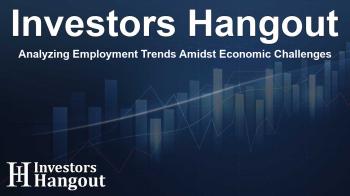Analyzing Employment Trends Amidst Economic Challenges

Examining June's Payroll Growth and Economic Indicators
In June, the Nonfarm Payrolls (NFP) data showed an upward trend, surpassing expectations largely due to the growth in education and health services employment. However, the private NFP figures revealed a contrasting scenario, indicating some setbacks. The S&P Global's GDP figures indicate a stagnation over the past six months leading up to May, highlighting that several key metrics monitored by the National Bureau of Economic Research (NBER) are either stable or on a decline. Nevertheless, the NBER emphasizes the importance of employment figures, which continue to rise, bolstered by increasing personal income.
Understanding Alternative Employment Indicators
This situation triggers the need for further examination of alternative indicators to understand the broader employment landscape. With Nonfarm Payrolls reflecting only a segment of the economy, it’s essential to delve into various employment measures. The contrasting figures, such as those presented from civilian employment revisions and industrial production, paint a more comprehensive picture of economic health.
The Importance of Employment Measures
While analyzing these figures, it's critical to note the weight of different employment measures, such as the Current Employment Statistics (CES) versus the Current Population Survey (CPS). Many economists lean more heavily on CES as it generally provides a more accurate depiction of employment conditions. However, if one believes that CPS signals potential recessions ahead of CES, there may be cause for concern. It’s important to observe that the data reflects historical trends, as the employment figures reflect activities primarily from the second week of June.
Emerging Economic Trends
While the latest data points to a slowing economy, evidenced by a decline that started in April and persisted into late June, it’s essential to analyze how these trends will impact future economic conditions. Looking at the weekly indicators, researchers note consistent patterns that can assist in predicting forthcoming economic scenarios.
Forecasting Future Employment Trends
The implications of these employment and economic indicators cannot be understated. With a backdrop of fluctuations in GDP and various employment measures indicating stability or declines, policymakers and economists must remain vigilant. The labor market dynamics coupled with slowing economic activity present a scenario that requires keen observation. As economic conditions evolve, it’s crucial to adapt and prepare for potential shifts in employment trends.
Final Thoughts on Current Economic Conditions
In summary, while June's payroll numbers appear promising, they are counterbalanced by other indicators suggesting a more sluggish economic landscape. It’s crucial to navigate these complexities to understand the full scope of economic health, especially as various sectors continue to grapple with challenges. Future assessments will need to consider these elements to gauge the overall outlook accurately.
Frequently Asked Questions
What are Nonfarm Payrolls (NFP)?
Nonfarm Payrolls represent the total number of paid workers in the U.S. excluding certain sectors, providing insights into employment trends.
How do employment indicators impact the economy?
Employment indicators show the vitality of the labor market, influencing consumer spending, economic growth, and policy decisions.
What are the main measures of employment?
The main measures include Current Employment Statistics (CES) and Current Population Survey (CPS), each providing different perspectives on labor market conditions.
Why are backward-looking data important?
Backward-looking data helps economists and analysts understand past trends that influence current economic policies and forecasts.
How can one interpret conflicting economic signals?
Conflicting signals require a detailed analysis of the broader economic context, assessing various indicators to form a comprehensive understanding.
About The Author
Contact Addison Perry privately here. Or send an email with ATTN: Addison Perry as the subject to contact@investorshangout.com.
About Investors Hangout
Investors Hangout is a leading online stock forum for financial discussion and learning, offering a wide range of free tools and resources. It draws in traders of all levels, who exchange market knowledge, investigate trading tactics, and keep an eye on industry developments in real time. Featuring financial articles, stock message boards, quotes, charts, company profiles, and live news updates. Through cooperative learning and a wealth of informational resources, it helps users from novices creating their first portfolios to experts honing their techniques. Join Investors Hangout today: https://investorshangout.com/
The content of this article is based on factual, publicly available information and does not represent legal, financial, or investment advice. Investors Hangout does not offer financial advice, and the author is not a licensed financial advisor. Consult a qualified advisor before making any financial or investment decisions based on this article. This article should not be considered advice to purchase, sell, or hold any securities or other investments. If any of the material provided here is inaccurate, please contact us for corrections.

